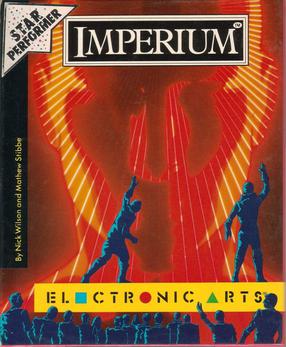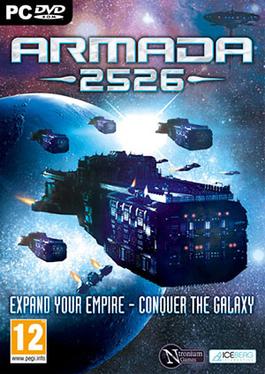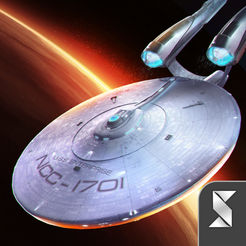
Master of Orion is a turn-based, 4X science fiction strategy game in which the player leads one of ten races to dominate the galaxy through a combination of diplomacy and conquest while developing technology, exploring and colonizing star systems.

Stars! is a turn-based strategy, science fiction 4X video game, originally developed by Jeff Johnson and Jeff McBride with help from Jeffrey Krauss for personal use, initially released as shareware for Microsoft Windows in 1995. A retail version was later produced for, and published by Empire Interactive, with developer Jason Gaston added to the team for quality assurance testing, although the shareware version continued.

4X is a subgenre of strategy-based computer and board games, and includes both turn-based and real-time strategy titles. The gameplay generally involves building an empire. Emphasis is placed upon economic and technological development, as well as a range of military and non-military routes to supremacy.
VGA Planets is a multi-player space strategy war game originally released in 1992. The game simulates combat in space between galactic scale empires. It follows the 4X game model: The players start with a home world, and have to build spaceships, explore the galaxy, colonize planets, mine minerals, build up their industry.

Anacreon: Reconstruction 4021 is a video game written by George Moromisato for MS-DOS and published by Thinking Machine Associates in 1987. Anacreon is a turn-based game in which human and computer players explore the galaxy, conquering worlds and putting them to use to fuel their war machines. The game resembles Stellar Conquest and Hamurabi. It was inspired by Isaac Asimov's Foundation series of novels.
The following outline is provided as an overview of and topical guide to video games:

Reach for the Stars is a science fiction strategy video game. It is the earliest known commercially published example of the 4X genre. It was written by Roger Keating and Ian Trout of SSG of Australia and published in 1983 for the Commodore 64 and then the Apple II in 1985. Versions for Mac OS, Amiga, Apple IIGS, and DOS were released in 1988.

Master of Orion II: Battle at Antares is a 4X turn-based strategy game set in space, designed by Steve Barcia and Ken Burd, and developed by Simtex, who developed its predecessor Master of Orion and Master of Magic. The PC version was published by MicroProse in 1996, and the Macintosh version a year later by MacSoft, in partnership with MicroProse. The game has retained a large fan base, and is still played online.

Sword of the Stars is a space 4X game developed by Kerberos Productions. In the game the player chooses one of four unique races to form an interstellar empire and conquer the galaxy. In order to win, the player must expand territory by colonizing new star systems, exploit the resources available to their colonies, design and build starships, and improve their empire's technology through research and strategy.

Sins of a Solar Empire is a 2008 science fiction real-time strategy video game developed by Ironclad Games and published by Stardock Entertainment for Microsoft Windows operating systems. It is a real-time strategy (RTS) game that incorporates some elements from 4X games; its makers describe it as "RT4X". Players are given control of a spacefaring empire in the distant future, and are tasked with conquering star systems using military, economic and diplomatic means.
Strategy is a major video game genre that emphasizes thinking and planning over direct instant action in order to achieve victory. Although many types of video games can contain strategic elements, as a genre, strategy games are most commonly defined as those with a primary focus on high-level strategy, logistics and resource management. They are also usually divided into two main sub-categories: turn-based and real-time, but there are also many strategy cross/sub-genres that feature additional elements such as tactics, diplomacy, economics and exploration.

Imperium is a 4X strategy video game published by Electronic Arts in 1990 for the Amiga, Atari ST, and DOS.

Armada 2526 is a 4X science fiction computer strategy game developed by British studio Ntronium Games, released in North America on November 17, 2009. Armada 2526 is an example of the space opera genre, and is the spiritual successor of the game Armada 2525, which was released by Interstel in 1991. Armada 2526 puts players in charge of a fledgling galactic empire, and they must attempt to explore the galaxy and expand their territory, while trying to destroy rival empires. The gameplay is a hybrid of turn-based and real-time time-keeping systems, and players can use military, diplomatic, economic and technological means to further their empires. The game received mixed reviews from critics.
Endless Space is a 4X turn-based strategy video game developed by Amplitude Studios and originally published by Iceberg Interactive. It was released on 4 July 2012, for Microsoft Windows and 31 August for Mac OS X. In the game, the player takes charge of fictional Space Age civilizations, expanding their influence by colonization and conquest. Endless Space sold over 1 million units, and earned the Unity Golden Cube award in 2013. The game's sequel, Endless Space 2, was released in 2017.

Outreach, subtitled "The Conquest of the Galaxy, 3000 AD", is a science fiction board wargame published by SPI in 1976 that simulates galactic empire building.

Stars in Shadow is a turn-based, 4X science-fiction computer strategy game developed by Ashdar Games and published by Iceberg Interactive for Windows PC in 2017.

Star Trek Fleet Command is a 4X "explore, expand, exploit, and exterminate" mobile strategy game created by Irish developer Digit Game Studios and published by Scopely and CBS Interactive. Players can explore star systems, build ships, mine resources, level up, complete missions, join alliances and battle other gamers.

Stellar Crusade is a 4X strategy video game released in 1988 by Strategic Simulations. Players control one or both of two spacefaring empires at war with each other, depending on whether it is played in a single-player campaign or multiplayer.
Star Trek: Ascendancy is a grand strategy game set in the Star Trek universe. it is published by Gale Force Nine.












